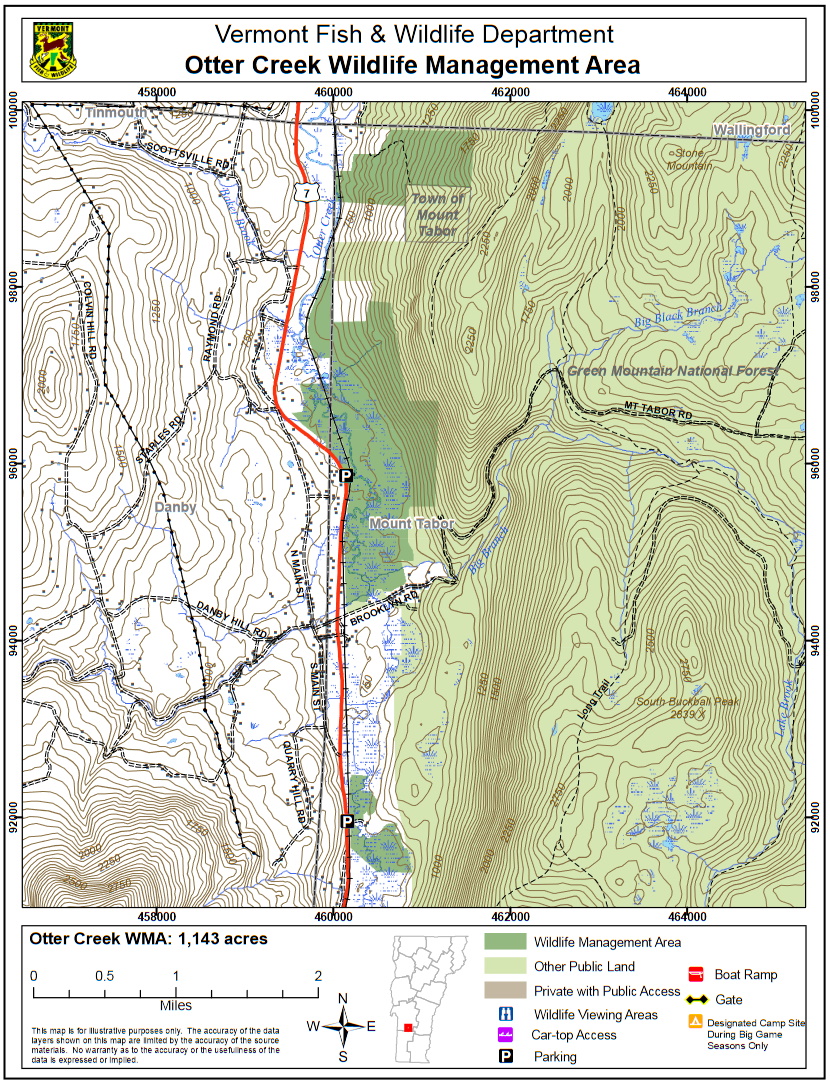Otter Creek WMA

Birds of Interest
The diversity of hardwood and softwood forest types interspersed with herbaceous open areas provides a habitat for numerous species of songbirds and raptors. This includes osprey, which can be seen along Otter Creek. The wetland complex associated with Otter Creek provides important habitat for a wide variety of waterfowl. The area affords good nesting habitat for wood, black and mallard ducks, teals, and mergansers, as well as various shorebirds. Woodcock are present in good numbers on the WMA, particularly in the alder swamps typical of the bottomlands along Otter Creek. Also associated with the brushlands along the Creek are fair numbers of ruffed grouse, which prefer early successional habitat.
About this Location
Otter Creek Wildlife Management Area (WMA) is a 1,139-acre tract that is owned by the State of Vermont and managed by the Vermont Fish and Wildlife Department. It is located along the Mount Tabor-Danby town line in Rutland County. The vast majority, 1,036 acres, lies in the town of Mount Tabor, with the remaining 103 acres in Danby. The property consists of three parcels; two are located approximately one and one-half miles north of Danby. The other is one mile south of Danby.
There is an improved parking lot and a couple of pull-outs along US-7 which provide access to the WMA.
The terrain of Otter Creek WMA is typical of the western foothills of the Green Mountains, ranging from the relatively flat valley floor to extremely steep, rough, stony slopes. Otter Creek is the major watercourse that runs along the western boundary of the WMA. Several small feeder streams traverse the parcel. The WMA lies within the Green Mountain physiographic region, which is known for severe climatic conditions. High-temperature variation exists because of the difference in elevation and topography in the region.
About 70% of Otter Creek WMA is forested. In total, softwood stands comprise some 190 acres. Hemlock is the dominant cover type comprising 56% of the softwoods, followed by white pine at 44%. The forest also has red and sugar maple, yellow birch, beech, red oak, and hickory. Approximately 260 acres of saturated scrub/shrub communities, open water, and emergent aquatic vegetation are designated as wetlands.
Herbaceous upland accounts for the remaining 66 acres. Approximately one-third of the northernmost 234-acre parcel is a deer wintering area, while over half of the middle parcel’s 815 acres are similarly designated. Management of at least portions of these deer yards has included commercial timber and firewood cuts to release hemlock, and also to establish openings to create browse for deer.
The entire southern parcel and the western third of the middle parcel have been classified as wetlands on the Department of Interior’s Natural Wetlands Inventory maps.
Hill’s pondweed, an aquatic plant preferring shallow, highly alkaline, muddy waters, was originally discovered in 1934 and again in 1982 close to if not within the WMA along Otter Creek. Hill’s pondweed was considered for federal listing as a threatened species at one time. It is considered to be uncommon by the Vermont Nongame and Natural Heritage Program of the Vermont Fish and Wildlife Department. Please remember that plants should not be picked or removed, regardless of status.
Features
Roadside viewing
Restrooms on site
Wheelchair accessible trail
Entrance fee
Content from Otter Creek Wildlife Management Area guide and map
Last updated December 3, 2023
